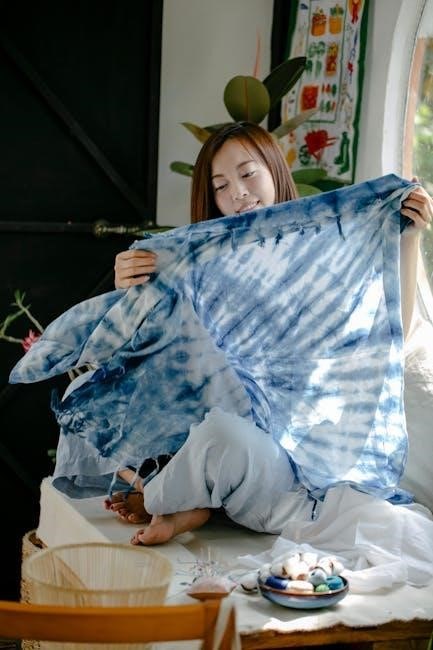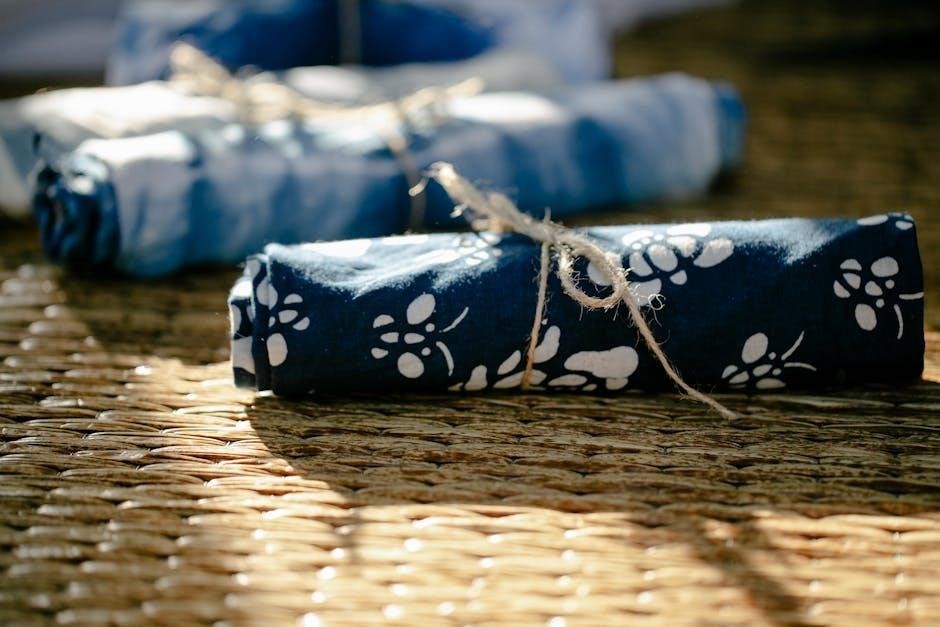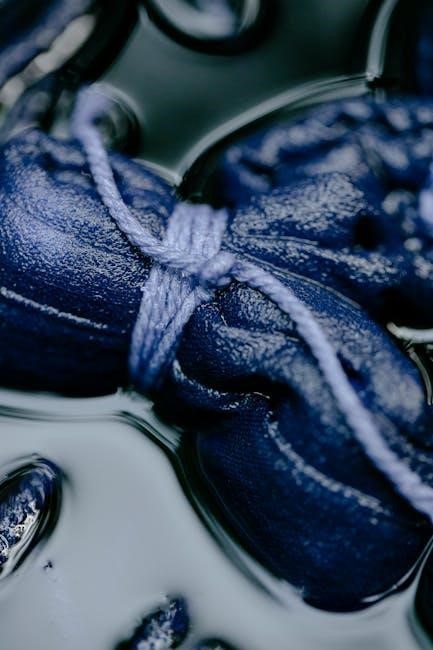Tie-dye fabrics require special care to preserve vibrant colors and unique patterns. This guide provides essential steps for washing, rinsing, and drying tie-dye items effectively.
1.1 Overview of Tie-Dye Process and Care
Tie-dye is a creative technique that involves folding, tying, and dyeing fabric to achieve unique patterns. Proper care ensures vibrant colors and prevents fading. The process begins with setting the dye for 6-8 hours, followed by rinsing excess dye in cold water until it runs clear. Removing rubber bands carefully is crucial to avoid damaging the design. Washing separately in hot water with mild detergent helps preserve colors, while air drying or using low heat prevents shrinkage and color loss. Regular washing with like colors and avoiding harsh chemicals maintains the fabric’s integrity. Following these steps ensures your tie-dye creations remain bright and intact for years.
1.2 Importance of Proper Washing Techniques
Proper washing techniques are vital to maintain the quality and appearance of tie-dye fabrics. Improper methods can lead to color bleeding, fading, or pattern distortion. Using cold water for initial rinsing prevents excessive dye loss, while hot water with mild detergent ensures deep cleaning without harming colors. Washing tie-dye items separately avoids transferring dyes to other fabrics. Avoiding bleach and harsh chemicals preserves the vibrancy of the colors. Following recommended care steps extends the lifespan of the fabric and keeps the unique tie-dye patterns intact. Neglecting these guidelines can result in dull, faded designs and damaged material, making proper washing essential for preserving the artistic value of tie-dye creations.

Preparing for Washing Tie-Dye Fabrics
Preparing tie-dye fabrics involves setting the dye, rinsing excess color, and removing ties. These steps ensure vibrant colors and prevent damage during the washing process.
2.1 Setting the Dye: Letting It Set for 6-8 Hours
Setting the dye is crucial for achieving vibrant, long-lasting colors. After applying the dye, allow the fabric to sit for 6 to 8 hours. This timeframe enables the dye to fully bind with the fabric, ensuring the colors remain intense. For even deeper hues, letting it set for 12 to 24 hours is recommended. During this period, keep the fabric in a plastic bag to maintain moisture and promote even color distribution. Avoid direct sunlight, as it may cause fading. Once set, the fabric is ready for rinsing and washing, which will remove excess dye while preserving the design.
2.2 Rinsing Excess Dye Before Washing
Rinsing excess dye is a critical step before washing tie-dye fabrics. After the dye has set, rinse the fabric under cold running water while it is still tied. This step removes loose dye particles that haven’t fully bound to the fabric. Wear gloves to protect your hands from staining. Gently rinse until the water runs relatively clear, ensuring no excess dye remains. Avoid untieing the fabric during rinsing to prevent color bleeding. Once rinsed, remove the rubber bands or ties and rinse again to eliminate any remaining dye residue. Proper rinsing ensures vibrant colors and prevents dye transfer during the washing process. This step is essential for maintaining the integrity and appearance of your tie-dye design.
2.3 Removing Rubber Bands or Ties
After rinsing excess dye, carefully remove the rubber bands or ties from the tie-dye fabric. This step should be done gently to avoid smudging or distorting the design. If the bands are tight, cut them with scissors to release the fabric without stretching it. Removing the ties allows the fabric to relax, revealing the unique patterns created during the dyeing process. Once the bands are removed, rinse the fabric again under cold water to ensure all excess dye is washed away. Properly removing the ties ensures the design remains intact and vibrant. This step is crucial before proceeding to the final washing cycle. Handle the fabric with care to maintain the integrity of the tie-dye design.

Washing Tie-Dye Fabrics
Wash tie-dye fabrics gently to preserve colors. Start with cold water to rinse excess dye, then use hot water and mild detergent for the main wash.
Always wash separately to prevent color bleeding and maintain vibrant patterns.
3.1 Using Cold Water for Initial Rinsing
The first rinse after tie-dyeing is crucial. Use cold water to gently remove excess dye without fading the colors.
This step prevents excessive dye loss during the main wash.
Run cold water over the fabric until it flows clear, ensuring the colors remain vibrant.
This process is essential for maintaining the integrity of the tie-dye design.
Always rinse thoroughly before proceeding to the next step.
3.2 Washing in Hot Water with Mild Detergent
After rinsing, wash the tie-dye fabric in hot water using a mild detergent free of bleach or harsh chemicals.
Hot water helps set the colors deeply into the fabric, ensuring longevity.
Use a gentle detergent to avoid damaging the fabric or fading the dyes.
Check the fabric type to determine the safest water temperature.
Wash separately from other clothes to prevent color transfer.
Avoid using fabric softeners, as they can affect color retention.
Gently agitate the fabric during the wash cycle to maintain the tie-dye pattern.
This step is crucial for preserving the vibrant colors and unique design.
3.3 Washing Separately to Prevent Color Bleeding
Washing tie-dye fabrics separately is crucial to prevent color bleeding and transfer.
Colors, especially bright or dark ones, may run during the first few washes.
Use cold water to minimize dye leakage and protect the fabric.
Place the tie-dye item in a mesh laundry bag for added protection.
Avoid mixing with lighter or white fabrics to prevent staining.
Check the care label for specific instructions on water temperature.
Gently agitate the fabric during the wash cycle.
Allow the fabric to air dry or tumble dry on a low setting.
Washing separately ensures the vibrant colors remain intact and prevents damage to other clothes.

Drying Tie-Dye Fabrics
Air drying is recommended to preserve colors and prevent shrinkage. Avoid high heat from machines, as it may fade dyes or damage fabric. Gently lay flat or hang to dry.
4.1 Air Drying vs. Machine Drying
Air drying is highly recommended for tie-dye fabrics to preserve colors and prevent shrinkage. Lay items flat or hang them to dry naturally, away from direct sunlight. Machine drying can fade colors and damage fabric, especially if high heat is used. If machine drying is preferred, use a low heat setting and a gentle cycle. Remove the item while still slightly damp to prevent wrinkles. Air drying ensures vibrant colors remain intact and maintains the fabric’s softness. Proper drying techniques are crucial for long-lasting results. Always prioritize air drying for the best care of your tie-dye creations. This method is gentle and effective, ensuring your unique designs stay bright and intact over time.
4.2 Avoiding High Heat to Preserve Colors
Avoiding high heat is crucial to preserve the vibrant colors of tie-dye fabrics. Excessive heat can cause dyes to fade and fabrics to shrink, damaging the unique patterns. When drying, air drying is the best option, as it prevents color bleeding and maintains fabric integrity. If machine drying is necessary, use a low heat setting and remove the item while it’s still slightly damp. Ironing should also be done on a low setting without steam to avoid damaging the fabric or fading the colors. By avoiding high heat, you ensure your tie-dye creations remain colorful and intact for a longer period. Proper care extends the life of your unique designs, keeping them vibrant and beautiful over time.

Additional Care Tips
Use water softeners and mild detergents to protect colors. Wash dark and bright items separately to prevent dye transfer. These tips enhance color preservation and fabric longevity.
5.1 Washing Dark and Bright Colors Separately
Washing dark and bright tie-dye colors separately is crucial to prevent dye transfer and fading. Darker shades, especially, may bleed excess dye during initial washes, potentially ruining lighter fabrics; This precaution ensures vibrant colors remain intact and prevents unwanted staining. For best results, sort items based on color intensity and wash similar hues together. Using cold water and mild detergents further safeguards against color loss. Additionally, washing tie-dye items inside out can reduce friction and protect the design. By following these steps, you can maintain the unique patterns and extend the lifespan of your tie-dye creations. Proper separation and care are essential for preserving both fabric quality and artistic detail.
5.2 Using Water Softeners and Special Detergents
Using water softeners and special detergents is vital for maintaining the vibrancy and integrity of tie-dye fabrics. Water softeners help remove mineral buildup, which can dull colors or affect dye adhesion. Special detergents, such as those designed for hand-dyeing or color-protecting, are gentle on fabrics and prevent excessive dye bleeding. Avoid harsh chemicals or bleach, as they can damage the fibers or fade the colors. For optimal results, use a mild detergent specifically formulated for vibrant or dyed fabrics. This ensures the colors stay rich and the fabric remains soft. Always check the detergent label for suitability with dyed materials to preserve the unique tie-dye patterns and extend the garment’s lifespan.
